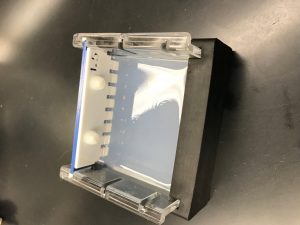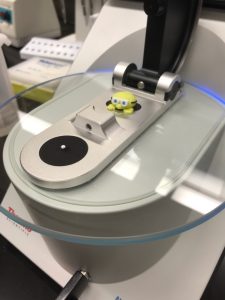4/5/18 chelex part 2
Date/Title: 4/5, Chelex
Purpose: improve upon our previous trials of the DNA extraction procedure. The chelex procedure yielded the best results from the last trial which is why everyone replicated this procedure again, instead of the MoBio method.
Methods:
- remove 1.5 ml of liquid from the non-flooded plate. spin @ 6000xg for 5 minutes and remove supernatant. repeat procedure (3 ml of pellet).
- add 200 µL 5% chelex to the pellet and vortex for 1 minute.
- add 15 µL of proteinase K
- incubate for 30 minutes in 56 degree C water bath.
- boil for 8 minutes in 100 degree C heat block
- vortex for 1 minute
- centrifuge @ 16,000xg for 3 minutes to pellet cellular debris and chelex beads
- transfer 100 µL of supernatant to a clean microcentrifuge tube.
- Label the top
- Negative control PCR: add 1.25 µL of V4 primer and 11.25 µL of water
- postive control: add 1.25 µL of V4 primer and 10.25 µL of water
- eDNA: add 1.25 µL of V4 primer and 10.25 µL of water
- add all PCR’s to the labelled microfuge tube with the supernatant.
- perform the nanodrop test.
- add 10 µL of PCR and water mixture to calibrate.
- Place 0.5 µL of supernatant onto the spectrophotometer and record the ng/µL .
Mistakes:
I spilled my supernatant on myself. Katy accidentally added the liquid from the non-flooded plate to the V4 primer, instead of the supernatant that we placed in the water bath.
Data: eDNA comes from the non-flooded plate and the DNA template is paramecium.
- 58.3 ng/µL
- A260/A280: 0.82
- A260/A230: 0.19
Conclusion:
The range for positive chelex was estimated to be 50 ng/µL. Our chelex was 58.3 ng/µL. This means that there was an error somewhere (due to pH change or salt from the beads), but this number is very close to the baseline. No dilution is necessary. The next step is running the DNA again to try and obtain more positive DNA results. Positive DNA results would be thick and distinct bands. The goal of the chelex experiment was to hopefully create DNA that will be suitable to analyze .
Labelled: CLK 22-2 chDNA and it is in the green rack on the front table. Our PCR tubes were labelled 22-2 +, 22-2 -, and 22-2 e/ entry for our ng/µL is D4 (1-3) -,+,e



